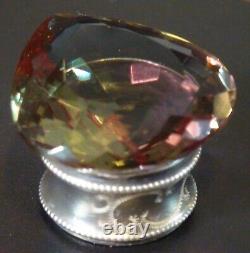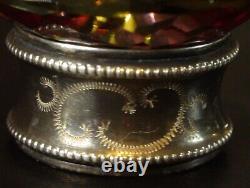
- Old Solid Silver
- Main Stone
- Matière
- Metal
- Origin
- Style
- Antique (17)
- Antiquity (24)
- Antiquité (75)
- Art Deco (167)
- Art Nouveau (52)
- Bangle (13)
- Boucle (44)
- Bracelet (19)
- Jonc (14)
- Louis Philippe (13)
- Louis Xvi (78)
- Manchette (16)
- Marquise (16)
- Napoleon Iii (62)
- Napoléon Iii (193)
- Napoléon, Empire (34)
- Renaissance (13)
- Restauration (18)
- Solitaire (18)
- Xixe (17)
- Other (3022)
- Type
- Bague Sertie (178)
- Bijou (78)
- Café, Thé (16)
- Chain (11)
- Chaîne (14)
- Chevalière (12)
- Christianisme (59)
- Christianity (27)
- Liqueur, Vin (10)
- Montre De Poche (35)
- Montre à Gousset (18)
- Objet De Métier (18)
- Pendantes (40)
- Pendentif (25)
- Pocket Watch (10)
- Sautoir (16)
- Set Ring (67)
- Tableware, Cooking (9)
- Tableware, Cuisine (70)
- Tableware, Kitchen (68)
- Other (3144)
Alexandrite, 121 carats, maximum color change, on an antique solid silver base.










Natural alexandrite is a variety of chrysoberyl that has the particularity of changing color with lighting. Alexandrite was described by Finnish mineralogist Nils Gustaf Nordenskiöld in 1842. The name alexandrite comes from that of Tsar Alexander II, to whom Nordenskiöld dedicated it on April 17, 1834. Our gemstone presents an extreme color-changing effect depending on the nature of the light, from red to green, very intense and magnificent. Please note, this is a synthetic alexandrite, or an imitation of alexandrite whose exact mineral composition is unknown to us.
A natural stone of this type would be worth tens of millions of dollars. In May 2014, a Russian alexandrite weighing 21.41 carats, cushion-cut, was sold for $1,495,395, or about €1,540,000. A famous alexandrite from Sri Lanka weighing approximately 65.7 carats is the largest faceted alexandrite.
It is currently housed at the Smithsonian Institution in the United States. The majority of alexandrites weigh less than one carat. Our stone, faceted in the shape of a heart or pear, weighs 121 carats, or 24.2 grams.
The base, old and unmarked (in fact, a non-French, barely legible, and unidentified mark), has been tested multiple times with acid and a touchstone and is made of solid silver. Jewelers use a stone called a "touchstone" to verify if a product is truly made of solid silver or not. The principle of operation of this touchstone is based on the reaction of silver with a mixture of 2/3 nitric acid and 1/3 hydrochloric acid. If it is silver, the trace will turn red. Multiple traces must be made in the same spot of the object to ensure it is not simply silver-plated.

